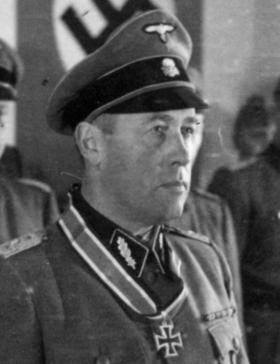User:GereonGG/sandbox
| 31st SS Volunteer Grenadier Division | |
|---|---|
| 31. SS-Freiwilligen-Grenadier-Division | |
 | |
| Active | 4 October 1944 – 9 May 1945 |
| Country | |
| Branch | |
| Type | Grenadier |
| Role | Infantry |
| Size | 14,800 (4 November 1944)[3] 11,000 (16 December 1944)[4] |
| Nickname(s) | 'Division Batschka' 'Division Kukuruz ' 'Division Lombard' 'Gruppe Lombard' |
| Motto(s) | "Meine Ehre heißt Treue!" |
| Engagements | |
The 31st SS Volunteer Grenadier Division (German: 31. SS-Freiwilligen-Grenadier-Division) (Hungarian: 31. SS-önkéntes-gránátoshadosztály) (Serbo-Croatian: 31. SS dobrovoljačka grenadirska divizija) was a German infantry division of the Waffen-SS during the Second World War, commanded by SS-Brigadeführer Gustav Lombard that was active from 4 October 1944 to 9 May 1945.[5][6] The division was initially mostly made up of Volksdeutsche craftsmen, farmers, and workers from Hungary, primarily the Bačka region. By 26 October 1944, Army Group South deployed the division despite its inadequate training and equipment.
By May 1945, the escalating pressure from the advancing Red Army led to the division being encircled, causing the remnants to retreat and attempt an escape. The division's main body elements headed South from Josefstadt to the direction of Königgrätz; however, due to a shortage of fuel, they were prevented from advancing further. The unit was dissolved in accordance with orders, and most small groups or individuals were eventually forced to surrender or were killed by Czech insurgents and the Red Army.
History



Formation
On 24 September 1944, an order was issued.
Kampfgruppe Syr
At the end of September 1944, the 31st SS Volunteer Grenadier Division received its first assignment. Parts of SS Volunteer Grenadier Regiment 80 and SS Volunteer Fusilier Battalion 31 from nearby Szenttamás took over security tasks for the refugee routes on the banks of the Banat Tisza. As early as 5 October 1944, the combat-ready elements of the 31st SS Volunteer Grenadier comprising SS Volunteer Grenadier Regiment 79, SS Volunteer Grenadier Regiment 80 and SS Volunteer Fusilier Battalion 31 began taking up positions on both sides of Bečej on the western bank of the Tisza river with SS-Brigadeführer Gustav Lombard being present until late at night. These units were placed under the control of SS-Sturmbannführer Sepp Syr and named after him as Kampfgruppe Syr. This Kampfgruppe was tactically placed under the command of Generalleutnant Fritz Kühlwein, commander of Kampfgruppe Kühlwein.
According to a telegram from 7 October 1944, the strength of Kampfgruppe Syr was estimated to be around 2,600 men. This included the remaining Bosnian Muslim soldiers from the 23rd Waffen Mountain Division SS 'Kama', as well as the combat-ready elements of SS Volunteer Grenadier Regiment 79, SS Volunteer Grenadier Regiment 80 and SS Volunteer Fusilier Battalion 31. A large number of the men in this Kampfgruppe were ex-reservists from the Royal Yugoslav Army, as well as the Royal Hungarian Army. This Kampfgruppe had already taken up positions on 5 October 1944 on the Tisza river to defend the Bačka, with the only German unit in front of the division's deployment area being the Brandenburg Division, along with the 1st, 2nd and 3rd Hungarian River Blockade Detachments.
Deployment
Uniforms and Insignia




Insignia
The divisional insignia was a twelve-pointed stag head and was chosen by SS-Brigadeführer, Gustav Lombard himself, who was known to be a very passionate hunter. The symbol also has ties to the legend that the largest twelve-pointer ever hunted hailed from the Bačka's Karapancsa forest.[1] In addition, the Gemenc forest is not far from where the division saw action, a nature reserve is part of the Danube-Drava National Park with estates once owned by Archduke Friedrich, where Kaiser Wilhelm II once hunted.[7] The symbol was used on vehicles and elsewhere from the beginning of November until the end of the war.
Proposals made by the medical officers in SS Volunteer Medical Abteilung 31 for the division logo to be a corn cob.
Misconceptions
In post-war literature, the 31st SS Division is often confused with Kampfgruppe Böhmen-Mähren, being ascribed the nickname of "Böhmen-Mähren'. At the end of the war, there were two SS regiments ‘Böhmen’ and ‘Mähren’ which were merged with other units to form a division under SS-Brigadeführer Wilhelm Trabandt, this division was designated as ‘Böhmen und Mähren'
Nicknames
The division was known by many unofficial nicknames.
Uniforms
Order of Battle
Type 1944 Infantry Division
Type 1945 Infantry Division
External Links
- 13th Waffen Mountain Division of the SS Handschar (1st Croatian)
- 23rd Waffen Mountain Division of the SS Kama (2nd Croatian)
- Battle of Batina
- Danube Swabians
- List of German divisions in World War II
- List of SS personnel
- List of Waffen-SS divisions
- Table of ranks and insignia of the Waffen-SS
- Volksdeutsche
- Waffen-SS foreign volunteers and conscripts
References
Footnotes
- ^ a b c Pencz 2010, p. 2.
- ^ zu Ploën 2011, p. 290.
- ^ Pencz 2010, p. 65.
- ^ Munoz 1991, p. 367.
- ^ Pencz 2010, p. 1.
- ^ Gensicke 2016, p. 55.
- ^ a b zu Ploën 2011, p. 8.
- ^ zu Ploën 2011, p. 70.
- ^ zu Ploën 2011.
- ^ zu Ploën 2011, p. 69.
Bibliography
- Munoz, A.J. (1991). Forgotten Legions: Obscure Combat Formations of the Waffen-SS. Axis Europa Books. ISBN 978-0-7394-0817-9. Retrieved 2024-01-04.
- Mitcham, S.W. (2007). German Order of Battle: Panzer, Panzer Grenadier, and Waffen SS divisions in World War II. Stackpole Books. ISBN 978-0-8117-3438-7. Retrieved 2024-01-04.
- Pencz, R. (2010). For the Homeland: The 31st Waffen-SS Volunteer Grenadier Division in World War II. Stackpole military history series. Stackpole Books. ISBN 978-0-8117-3582-7. Retrieved 2024-01-04.
- ""A 31. SS-önkéntes-gránátoshadosztály (31. SS-Freiwilligen-Grenadier-Division)"". arcanum.com (in Hungarian). Retrieved 2024-01-04.
- zu Ploën, F.C. (2011). Vor Haus und Hof und Kind und Weib: mit der 31. SS-Division an der Donau und in Schlesien ; eine Divisionschronik (in German). Francovilla. ISBN 978-963-08-3134-5. Retrieved 2024-05-26.
